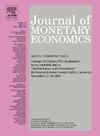Turbulent business cycles
IF 4.1
2区 经济学
Q1 BUSINESS, FINANCE
引用次数: 0
Abstract
Firm-level evidence suggests that turbulence that reshuffles firms’ productivity rankings rises sharply in recessions. An increase in turbulence reallocates labor and capital from high- to low-productivity firms, reducing aggregate TFP and the stock market value of firms. A real business cycle model with heterogeneous firms and financial frictions can generate the observed macroeconomic and reallocation effects of turbulence. In the model, increased turbulence makes high-productivity firms less likely to remain productive, reducing their expected equity values and tightening their borrowing constraints relative to low-productivity firms. This leads to a reallocation that reduces aggregate TFP. Unlike uncertainty, turbulence changes both the conditional mean and the conditional variance of the firm productivity distribution, enabling a turbulence shock to generate a recession with synchronized declines in aggregate activities.
动荡的商业周期
企业层面的证据表明,在经济衰退中,重新洗牌企业生产率排名的动荡会急剧上升。动荡的增加将劳动力和资本从高生产率企业重新分配到低生产率企业,降低了企业的总TFP和股票市场价值。具有异质企业和金融摩擦的真实商业周期模型可以产生观察到的宏观经济和再配置效应。在该模型中,增加的动荡使高生产率企业不太可能保持生产率,从而降低了它们的预期股本价值,并收紧了它们相对于低生产率企业的借贷约束。这导致了再分配,从而降低了总TFP。与不确定性不同,动荡改变了企业生产率分布的条件均值和条件方差,从而使动荡冲击产生经济衰退,同时导致总体活动同步下降。
本文章由计算机程序翻译,如有差异,请以英文原文为准。
求助全文
约1分钟内获得全文
求助全文
来源期刊

Journal of Monetary Economics
Multiple-
CiteScore
7.20
自引率
4.90%
发文量
90
审稿时长
74 days
期刊介绍:
The profession has witnessed over the past twenty years a remarkable expansion of research activities bearing on problems in the broader field of monetary economics. The strong interest in monetary analysis has been increasingly matched in recent years by the growing attention to the working and structure of financial institutions. The role of various institutional arrangements, the consequences of specific changes in banking structure and the welfare aspects of structural policies have attracted an increasing interest in the profession. There has also been a growing attention to the operation of credit markets and to various aspects in the behavior of rates of return on assets. The Journal of Monetary Economics provides a specialized forum for the publication of this research.
 求助内容:
求助内容: 应助结果提醒方式:
应助结果提醒方式:


